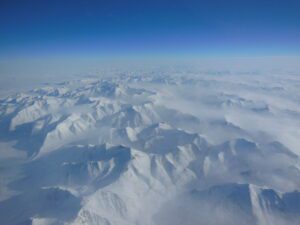Alaska’s grandeur certainly lies in its massive mountain ranges that dominate the landscape, making it a land of giants. These mountains are the backbone of the Gulf of Alaska, forming a rugged and icebound buttress that extends over an 800-mile arc. This stunning mountain range spans from Ketchikan in the southeast to Anchorage and Kenai in Cook Inlet, covering a vast distance that adds to its magnificence.
Denali‘s towering height is just one of the many awe-inspiring features of the Alaska Mountains. In addition, it is also one of the largest geographic features on Earth and a famous white massif in the Alaska Mountains. However, it’s not alone. In fact, twelve of the thirteen tallest peaks in the country, and around one-fifth of the 200 highest summits in North America, are located in the Alaska Mountains.

Geology
The Alaska Mountain Range is a fascinating example of how geological forces have shaped the North American continent. Specifically, this incredible mountain range owes its existence to a series of uplift and erosion processes driven by tectonic activity over millions of years.
The Alaska Mountains range is home to the magnificent Denali, which owes its impressive stature to several factors. The impact of two major faults, the Denali Fault and the Hines Creek Fault have contributed to shaping the landscape. Furthermore, uplift from these faults has caused the mountains to continue growing, which has resulted in significant earthquakes in the region.
In addition to the impact of faults, the Alaska Mountains owe their impressive height to the presence of large granite batholiths. The batholiths make the mountains highly resistant to erosion, further contributing to the inspiring character of the landscape.
Topography
The Alaska Mountain Range has a unique topography that draws adventurers globally. With their vast expanse and icy allure, the mountains of the Yukon Territory and the Alaska Peninsula offer a beautiful view. Among the attractions are the magnificent Castner, Canwell, and Black Rapids glaciers, some of the largest in the area.
The range is also home to four major rivers: The Delta, Nenana, Nabesna, and Chisana, which cut through the rugged terrain, carving out deep valleys and creating a stunning landscape.
Given that the Alaska Mountains Range is located in the Pacific Ring of Fire and straddles the Denali Fault, it’s no surprise that volcanic eruptions and earthquakes are frequent. As a result of its dynamic geological history, the range boasts a striking shape and topography.
Climate
The climate of the Alaska Mountains Range is equally as varied as the mountains themselves. The southern slopes have a relatively mild temperature. January is the coldest month, with average temperatures ranging from 7˚F to 23˚F (-14˚C to -5˚C). While July is the hottest month, with average temperatures ranging between 52˚ F and 68˚F (11˚C and 20˚C).
In contrast, the northern slopes of the Alaska Mountains have more extreme temperatures. It ranges from -70˚F to 90˚F (-57˚C to 32˚C) depending on elevation.
Denali, renowned as the world’s coldest mountain due to its subarctic location and towering elevation, is known for its unpredictable weather patterns. The Alaska Mountain Range receives substantial rainfall and snow, contributing to glacier growth.
The four major Alaska mountain ranges
Alaska generally divides into five regions: The Northwest and Arctic region, Interior Region, Southwest Region, Southcentral Region, and Southeast Region. Fourteen major mountain ranges exist within these regions.
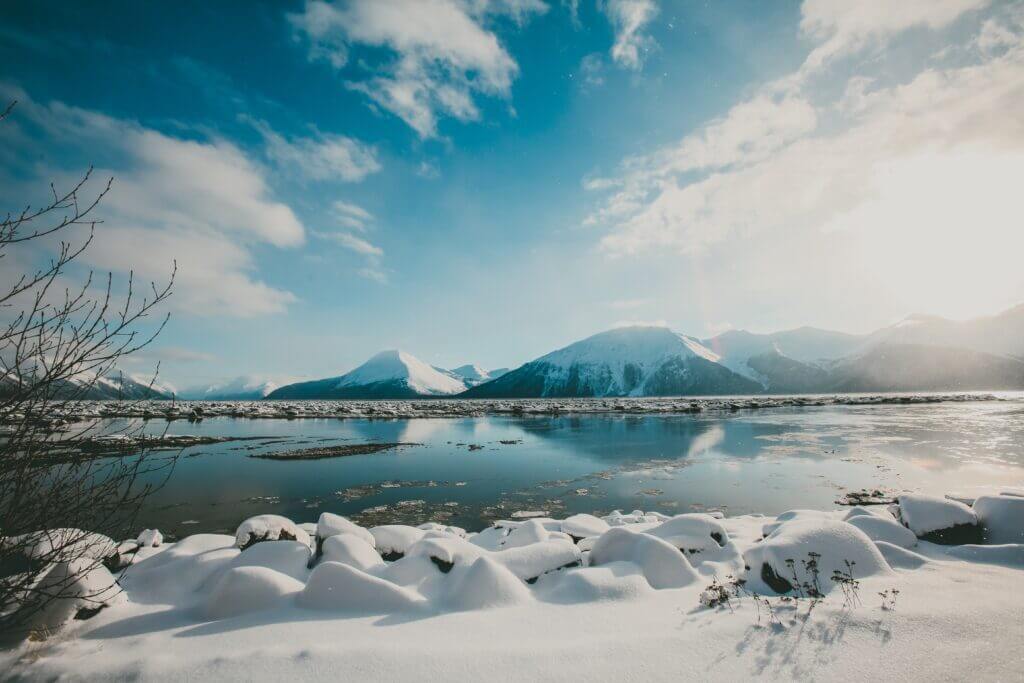
The Alaska Range: Home to the Tallest Mountain in North America
Highest Peak: Denali, 20,310 ft (6190.5 m)
Notable Mountains:
- Denali is the tallest mountain on the North American continent and is presently one of the tallest mountains in the world.
- Spurr, an active volcano west of Anchorage, erupted in 1992 and covered Anchorage with a thin layer of ash.
Nestled in the heart of Alaska’s Southcentral and Interior regions lies the breathtaking Alaska Range, a true wonder of the natural world. At its centre stands the majestic Mount McKinley, also known as Denali, towering above the land at an impressive height of 17,000 feet.
The Alaska Range is an awe-inspiring landscape of rugged beauty. Its snow-capped peaks, vast glaciers, and lush valleys make it a top destination for adventure seekers and nature enthusiasts alike.
The Coast Range: The Perfect Climate for Tree Growth
Highest Peak: Kate’s Needle, 10,016 feet (3,053 meters)
The rugged Coast Range and the awe-inspiring Wrangell-St. Elias Mountains stand majestically as nature’s boundary between Southeast Alaska and Canada. Home to over half of Alaska’s towering peaks, this magnificent range includes the formidable St. Elias, reaching an impressive 18,009 feet into the sky. As the warm, moisture-laden air from the Pacific Ocean sweeps across these giants, it ascends and cools, unleashing a torrent of rain upon the land below.
This constant deluge nurtures the verdant forests that envelop Southeast Alaska, creating an enchanting landscape for adventurers to explore and revel in.
The Brooks Range: A Rocky Mountain Range with Ancient Origins
Highest Peak: Mt. Isto, 8,976 ft (2736 m)
Notable Mountains:
- The Arrigetch Peaks are some of Alaska’s breathtaking peaks and are considered the most dramatic in the western Brooks Range.
The Brooks Range stands as an awe-inspiring natural border between Alaska’s Arctic and Interior regions and is a part of the Rocky Mountains. This range has a rich and fascinating history that dates back to a time, even before the existence of the dinosaurs. Geologists believe that these budding mountains were once the shore of the Arctic Ocean, and this makes the Brooks Range a true geological wonder. The rugged peaks, vast glaciers, and winding valleys that form this range make it a breathtaking landscape.
The Aleutian Range: An Active Volcanic Range
Highest Peak: Redoubt, 10,197 feet (3,108 meters)
Notable Mountains:
- Iliamna and Redoubt are two active volcanoes.
- Katmai, a volcano that erupted in 1912, threw about 33 million tons of rock into the air over two days. Ash and dust were blown as high as 25 miles (40 km) into the air.
Spanning an impressive 600 miles, the Aleutian Range extends along the Alaska Peninsula and weaves its way through the captivating Aleutian Islands. Housing some of the most dynamic volcanoes on the planet, these dramatic peaks form a segment of the notorious Ring of Fire—an unpredictable, restless arc of Earth’s crust. Among these fiery giants, Mount Redoubt made headlines with its most recent eruption in 2009.
Undeterred by the ever-present threat of volcanic activity, thrill-seekers and outdoor aficionados continue to flock to the Aleutian Range, drawn by the irresistible allure of untamed adventure.
Notable Alaska Mountains And Peaks
Alaska boasts a stunning 3844 named mountains, earning it the well-deserved monikers of “the last frontier” and “the land of the midnight sun.” However, it is truly infamous for its breathtaking, craggy high-altitude summits and its rugged, wild terrain. The power and beauty of the Alaska Mountains are evident in the towering summit of Denali and the famous Mount Marathon.
Five tallest Alaska Mountains
Denali

- Mountain range: Alaska Range
- Height: 20,310 ft (6190.5 m)
- Fun fact: The local Athabaskan people call it the “Great One.”
Denali is undoubtedly the most impressive of all of Alaska’s mountains. It towers over 6 million acres of rolling tundra & taiga forest, and Mount Denali is also a vast wall of granite, snow, and ice.
Denali dominates the landscape with its vast granite, snow, and ice wall. Climbing Denali is a serious mountaineering challenge that requires skill, experience, and equipment. However, there are other ways to experience the grandeur of this incredible mountain, such as taking a helicopter tour or a flightseeing tour by light aircraft over the snow-capped summit.
Talkeetna, the artsy and boho town, is the base for visiting Denali. Enjoy cool restaurants, old-fashioned saloons, and a buzz from climbers preparing for their ascent. Watch the mountain glow with burnt orange and pink hues at sunrise or sunset. Take a stroll and enjoy the breathtaking view.
Mount Saint Elias

- Mountain range: Saint Elias Mountains
- Height: 18,009 ft / 5489 m
- Fun fact: It was the site of an epic skiing descent in 2007. It broke records for the longest skiing descent on the planet.
Standing tall as the second loftiest summit in both the United States and Canada, Mount Saint Elias straddles the border between Alaska and the Yukon Territory, commanding awe and admiration. Its exceptional oceanic proximity distinguishes it as the highest mountain nearest to the sea. The fascinating tale of its genesis further adds to its allure: born from the colossal collision of the North American tectonic plate with the Pacific plate, this formidable peak was sculpted by nature’s powerful forces.
Today, Mount Saint Elias serves as a sought-after destination for intrepid explorers and adventure aficionados who are eager to witness its magnificence first-hand.
Mount Foraker
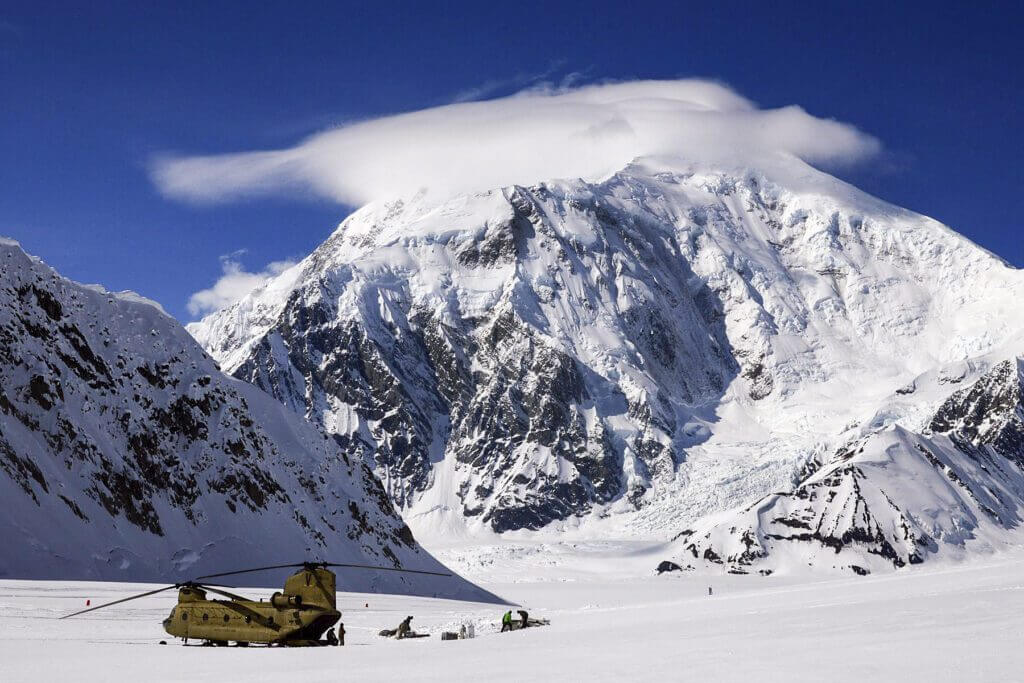
- Mountain range: Alaska Range
- Height: 17,400 ft / 5304 m
- Fun fact: When viewed from Anchorage, Mount Foraker appears to be the same height as Denali.
Nestled in the heart of Alaska, Mount Foraker is the third tallest peak in the Alaska Mountain Range. But what sets this mountain apart is its cunning ability to appear just as tall as its neighbouring peak, Denali. Despite being 3000 feet shorter and located 14 miles southwest of Denali, Mount Foraker constantly competes for the title of tallest peak.
Mount Bona
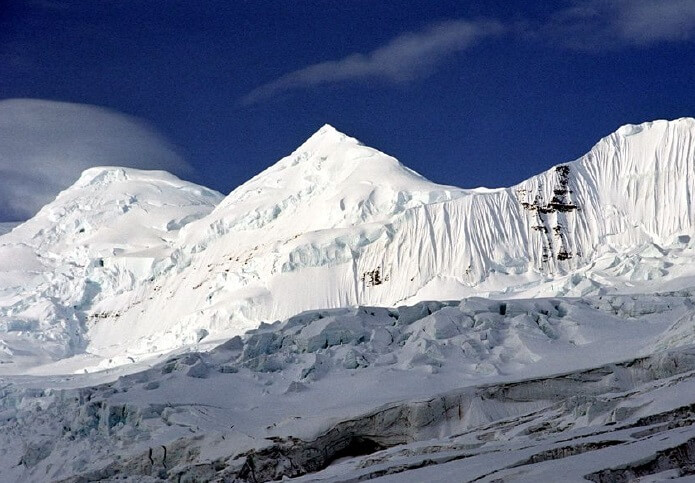
- Mountain range: Saint Elias Mountains
- Height: 16,550 ft / 5044 m
Mount Bona is the fourth-highest mountain in both Alaska and North America. It is a stratovolcano consisting of various ash layers, pumice, tephra, and hardened lava. Additionally, Mount Bona is covered in ice and serves as the primary source of ice for the 40-mile-long Klutlan Glacier.
Mount Blackburn
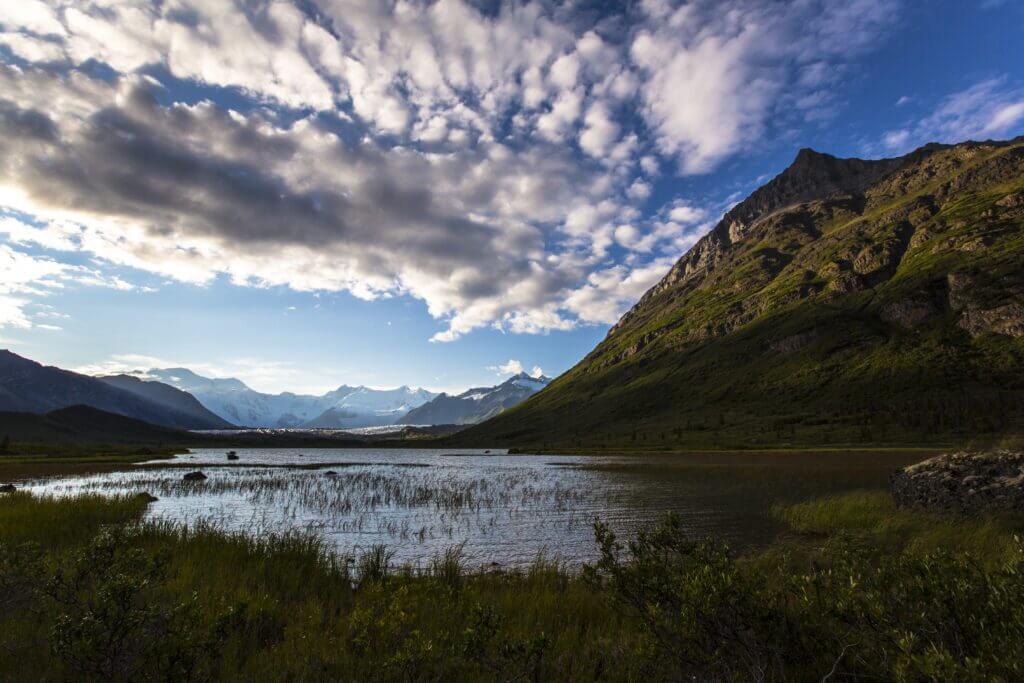
- Mountain range: Wrangell Mountains
- Height: 16,390 ft (4996 m)
Mount Blackburn is the fifth tallest in Alaska Mountains and the highest peak in the Wrangell Mountains. This eroded shield volcano is covered in ice and is the primary source of ice for massive glaciers. Moreover, Mount Blackburn is also the second-highest shield volcano in the US and the fifth-highest peak in North America. Climbing this towering peak is challenging, with its snow-capped peak providing an awe-inspiring view of the surrounding landscape.
5 Alaska Mountains to Add to Your Bucket List
Mount Hunter

- Mountain range: Alaska Range
- Height: 14,573 ft (4442 m)
- Fun fact: Known by the native people as ‘Begguya’ which means ‘Denali’s child
Mount Hunter the third-highest peak in the Alaska Mountain Range. Though shorter than Denali, Mount Hunter poses a greater challenge to climbers due to its steep and long snowy ridges. In fact, the first successful ascent was not achieved until 1954 by Fred Beckey, Henry Meybohm, and Heinrich Harrer. Despite the challenges, Mount Hunter continues to draw mountaineers worldwide eager to conquer this peak.
Mount Deborah

- Mountain range: Alaska Range
- Height: 12,339 ft (3761 m)
Mount Deborah, located in the Alaska Mountain Range, is one of the most renowned peaks in the region. Though its peak is relatively low in elevation compared to other major peaks in North America, it still poses a formidable challenge to climbers. With its steep slopes and rapid elevation gain, Mount Deborah is not for the faint of heart. But climbers who dare to tackle this peak must be well-prepared and experienced to navigate its challenging terrain.
Mount Alyeska

- Mountain range: Chugach mountain range
- Height: 3,939 ft (1,200 m)
- Fun fact: It offers a scenic tramway ride with views of seven hanging glaciers
Just a 40-minute drive from Anchorage and close to Girdwood, Alyeska is a chic ski resort in the winter and equally a stunning summer spot for hiking and mountain biking. Experience the magnificence of the mountain on the Alyeska Tramway, a 7-minute ride to an elevation of 2,300 feet. While exploring the region, visitors should keep a close eye out for bears and moose that may be present in the forests below. Afterwards, visitors can indulge in an Alaskan seafood dining experience at the Seven Glaciers Restaurant. It is an AAA Four-Diamond establishment situated atop the mountain. Make reservations to secure a table ahead of time due to its high demand.
Alternatively, those seeking an adrenaline rush can head to Alyeska’s Bike Park. The park offers mountain biking trails for all levels, from a gentle cruise through flower-filled meadows to mud trails down the mountain face.
Mount Susitna

- Mountain range: Alaska Range
- Height: 4,396-foot (1,340 m)
- Fun fact: Mount Susitna, also known as Sleeping Lady.
Mount Susitna is a prominent peak on the western skyline of Anchorage. The Susitna River flows along its base towards the sea to add more to its beauty. A breathtaking way to see this beauty is from the air, where you can fly over glaciers such as Matanuska-Susitna, Eklutana, Chickaloon, and Knik. An even more extended aerial journey can take you through the lower but equally stunning Chugach Mountain Range, Talkeetna Mountain Range, and the Sleeping Lady while looking for wildlife in the Susitna River watershed.
Mount Marathon

- Mountain range: Kenai Mountains
- Height: 4,826-foot (1,471 m)
- Fun Fact: Mount Marathon hosts an annual Independence Day race that attracts 1,000 runners from all over to tackle its gruelling three-mile course.
Mount Marathon is one of the toughest mountains in Alaska. The three-mile race is indeed a tough challenge. First, participants must climb a 3,022-foot rock face, which is already quite high! At the halfway point, they reach the top, but they’re not done yet. They then need to come back down. The journey back can be challenging, leaving the participants covered in mud and bruises.
But you don’t have to be a race participant to tackle Mount Marathon because you can also take the more realistic pace and follow the Jeep Trail. Discover two additional trails taking you through spruce forests and above the treeline on a 4.25-mile hike from downtown to Summit Ridge.
Scale the peak on a clear day to witness the stunning Resurrection Bay and the vast Harding Icefield. Evidently, the breathtaking views are worth it!
In conclusion
In conclusion, Alaska’s diverse and awe-inspiring mountain ranges, encompassing the Alaska Range, Coast Range, Brooks Range, and Aleutian Range, offer an incredible array of geological wonders, unique topography, and a variety of climates. Home to the tallest peaks in North America, including the colossal Denali, these ranges attract adventurers and nature enthusiasts from all over the world. The dynamic geological processes, tectonic activity, and presence of granite batholiths have shaped these stunning landscapes and continue to contribute to their ongoing evolution.
With a rich variety of attractions, from glaciers and rivers to vast forests and active volcanoes, Alaska’s mountains provide an unforgettable experience for those who venture to explore their grandeur.

